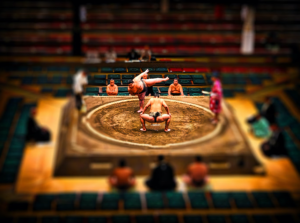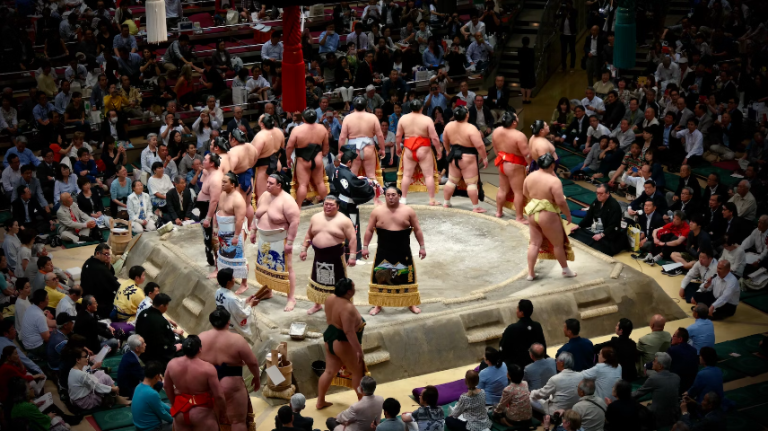Japan, a land of ancient traditions and modern marvels, has given the world a unique form of martial art that stands as a testament to its rich cultural heritage: Sumo Wrestling. This traditional sport, deeply embedded in Japan’s history, is not just a test of strength but a confluence of discipline, technique, and spirituality. This article delves into the origins, rules, cultural significance, and the life of a Sumo wrestler, offering a comprehensive look into a world where tradition meets athleticism.
The Origins of Sumo Wrestling
Sumo wrestling, often simply referred to as ‘Sumo’, is deeply rooted in Japan’s history and culture. This section delves into the origins and early history of this traditional martial art.
- The Ancient Rituals: Sumo’s origins can be traced back to the Yayoi period (300 BC – 300 AD). Initially, it was intertwined with Shinto rituals, serving as a form of entertainment for the deities. These early matches were not just about strength but also symbolized the human desire to appease the gods.
- Transition to Sport: Over time, Sumo evolved from a religious ritual to a popular form of entertainment. By the Heian period (794-1185), it had become a sport practiced by warriors and was gradually integrated into Japan’s courtly culture.
The transformation of Sumo from a sacred ritual to a widely appreciated sport is a testament to its enduring appeal and cultural significance in Japan.
The Rules and Techniques of Sumo
While Sumo is often perceived as a simple test of strength, it is governed by a set of intricate rules and techniques that competitors must master.
- The Ring: Sumo matches take place in a circular ring known as a ‘dohyō’. The primary objective is to force the opponent out of this ring or make any part of their body, other than the soles of their feet, touch the ground.
- Key Techniques: Wrestlers employ a variety of techniques, or ‘kimarite’, to achieve victory. These include throws, slaps, and various leg trips. Mastery of these techniques is essential for success in the ring.
- Forbidden Moves: Certain actions, such as punching, eye-gouging, or hair-pulling, are strictly prohibited in Sumo and can lead to disqualification.
The complexity of Sumo’s rules and techniques adds depth to the sport, making it a captivating spectacle for both participants and spectators.
Sumo’s Cultural Significance
Beyond the physical combat, Sumo holds a special place in Japan’s cultural and spiritual landscape.
- Religious Undertones: Even today, elements of Shinto rituals are evident in Sumo. Before each match, wrestlers perform purification rituals, reminiscent of the sport’s religious origins.
- Role in Society: Sumo wrestlers, or ‘rikishi’, are highly respected in Japanese society. Their dedication, discipline, and adherence to tradition make them revered figures.
Sumo it’s a reflection of Japan’s cultural and spiritual values, making it an integral part of the nation’s identity.
The Life of a Sumo Wrestler
Becoming a Sumo wrestler is a demanding journey, requiring immense dedication and discipline.
- Training Regime: Wrestlers live in communal training stables, or ‘heya’, where they undergo rigorous training routines, starting from the early hours of the morning.
- Diet and Lifestyle: A Sumo wrestler’s diet is carefully curated to build strength and stamina. The staple dish, ‘chanko-nabe’, is a hearty stew consumed in large quantities.
- Challenges and Rewards: The path to becoming a top-tier wrestler is fraught with challenges. However, those who rise to the top enjoy immense fame and adulation.
The life of a Sumo wrestler is one of sacrifice and perseverance, but the rewards, both tangible and intangible, are significant.
A Day in the Life of a Sumo Wrestler
Beyond the grand tournaments and the spotlight, the life of a Sumo wrestler is one of rigorous discipline, tradition, and dedication. This section offers a glimpse into the daily routine, training, and lifestyle of these athletes.
A Sumo wrestler’s day begins early, often before sunrise. The morning is dedicated to training, which starts with a series of traditional exercises to improve flexibility, strength, and technique. This includes practices like ‘shiko’ (leg-stomping exercises) and ‘teppo’ (a series of side-to-side slaps).
Table: Daily Schedule of a Sumo Wrestler
| Time | Activity |
| 5:00 AM | Wake up |
| 5:30 AM – 8:00 AM | Morning training |
| 9:00 AM | Breakfast (Chanko-nabe) |
| 10:00 AM – 12:00 PM | Rest |
| 12:30 PM | Lunch |
| 1:00 PM – 4:00 PM | Afternoon training |
| 5:00 PM | Dinner |
| 9:00 PM | Bedtime |
Central to a Sumo wrestler’s diet is ‘chanko-nabe’, a hearty stew made with meat, tofu, and vegetables. This dish provides the necessary calories and nutrition to sustain their intense training regimen. Meals are communal, and wrestlers often eat together in large groups.
After a day of rigorous training, evenings are relatively relaxed. Wrestlers might engage in activities like massage therapy to soothe their muscles, watch videos of their matches to analyze their performance, or simply rest and prepare for the next day.
The life of a Sumo wrestler is a testament to their unwavering dedication to the sport. Every aspect, from their daily routine to their diet, reflects the discipline and commitment required to excel in the Sumo ring.
In sum, Sumo wrestling, with its rich history, intricate techniques, and deep cultural roots, is more than just a martial art. It’s a living testament to Japan’s traditions and values. Whether you’re a passionate fan or a curious observer, the world of Sumo offers a fascinating glimpse into the soul of Japan.






+ There are no comments
Add yours